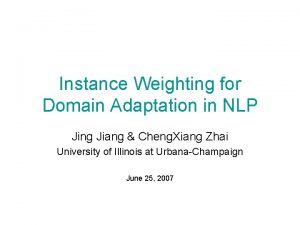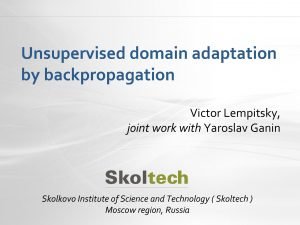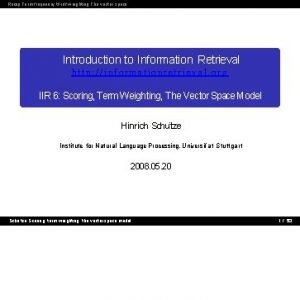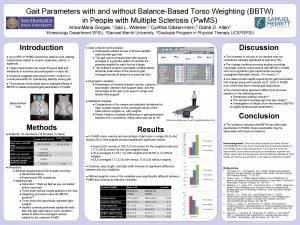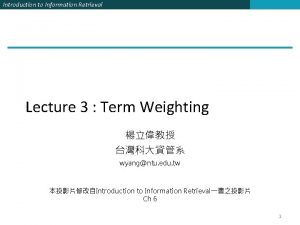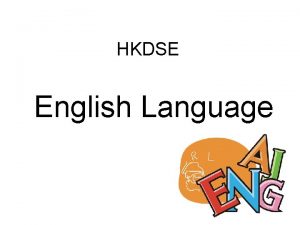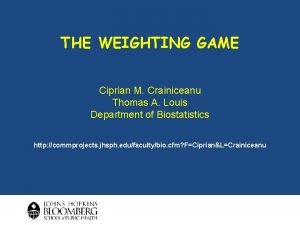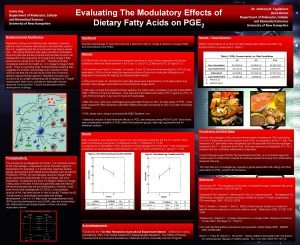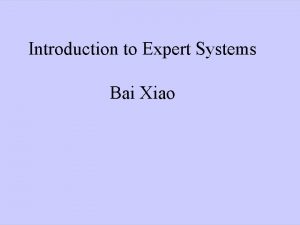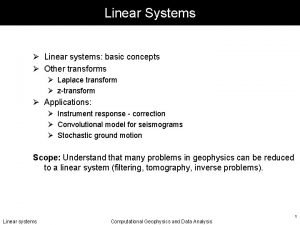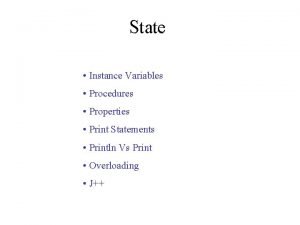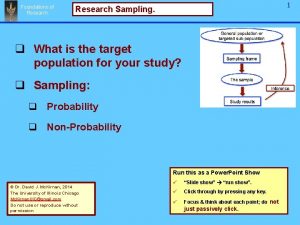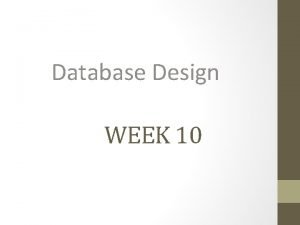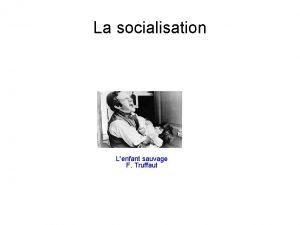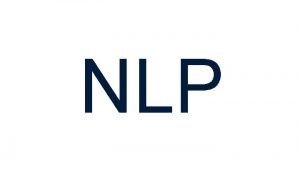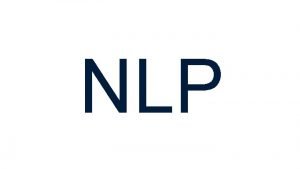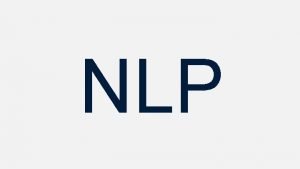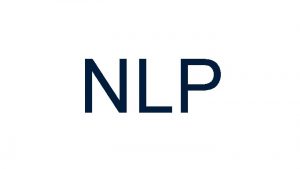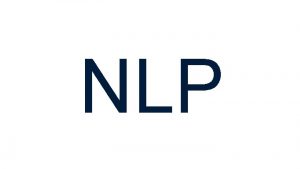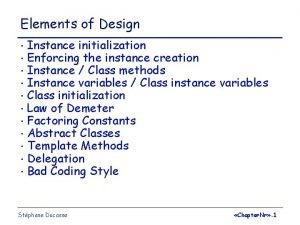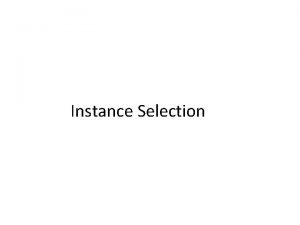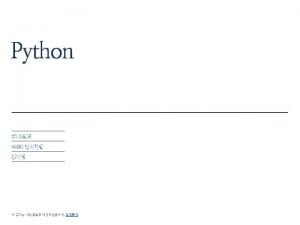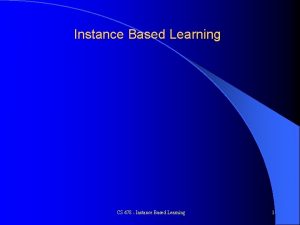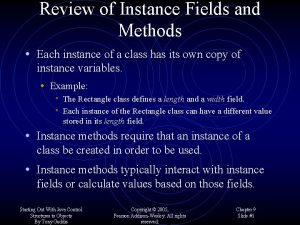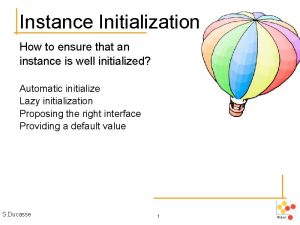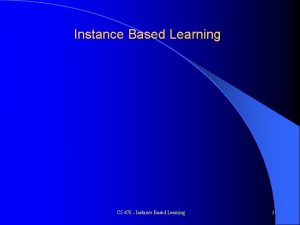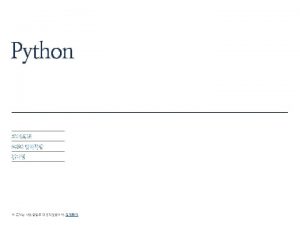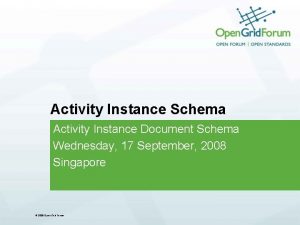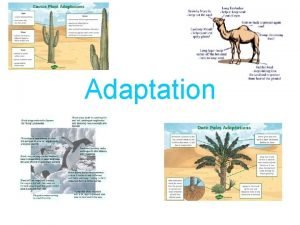Instance Weighting for Domain Adaptation in NLP Jing








































- Slides: 40

Instance Weighting for Domain Adaptation in NLP Jing Jiang & Cheng. Xiang Zhai University of Illinois at Urbana-Champaign June 25, 2007

Domain Adaptation • Many NLP tasks are cast into classification problems • Lack of training data in new domains • Domain adaptation: – POS: WSJ biomedical text – NER: news blog, speech – Spam filtering: public email corpus personal inboxes • Domain overfitting NER Task Train → Test F 1 to find PER, LOC, ORG from news text NYT → NYT 0. 855 Reuters → NYT 0. 641 mouse → mouse 0. 541 fly → mouse 0. 281 to find gene/protein from biomedical literature 2

Existing Work on Domain Adaptation • Existing work – Prior on model parameters [Chelba & Acero 04] – Mixture of general and domain-specific distributions [Daumé III & Marcu 06] – Analysis of representation [Ben-David et al. 07] • Our work – A fresh instance weighting perspective – A framework that incorporates both labeled and unlabeled instances 3

Outline • • Analysis of domain adaptation Instance weighting framework Experiments Conclusions 4

The Need for Domain Adaptation source domain target domain 5

The Need for Domain Adaptation source domain target domain 6

Where Does the Difference Come from? p(x, y) ps(y | x) ≠ pt(y | x) p(x)p(y | x) ps(x) ≠ pt(x) labeling difference labeling adaptation instance difference ? instance adaptation 7

An Instance Weighting Solution (Labeling Adaptation) source domain target domain pt(y | x) ≠ ps(y | x) remove/demote instances 8

An Instance Weighting Solution (Labeling Adaptation) source domain target domain pt(y | x) ≠ ps(y | x) remove/demote instances 9

An Instance Weighting Solution (Labeling Adaptation) source domain target domain pt(y | x) ≠ ps(y | x) remove/demote instances 10

An Instance Weighting Solution (Instance Adaptation: pt(x) < ps(x)) source domain target domain pt(x) < ps(x) remove/demote instances 11

An Instance Weighting Solution (Instance Adaptation: pt(x) < ps(x)) source domain target domain pt(x) < ps(x) remove/demote instances 12

An Instance Weighting Solution (Instance Adaptation: pt(x) < ps(x)) source domain target domain pt(x) < ps(x) remove/demote instances 13

An Instance Weighting Solution (Instance Adaptation: pt(x) > ps(x)) source domain target domain pt(x) > ps(x) promote instances 14

An Instance Weighting Solution (Instance Adaptation: pt(x) > ps(x)) source domain target domain pt(x) > ps(x) promote instances 15

An Instance Weighting Solution (Instance Adaptation: pt(x) > ps(x)) source domain target domain pt(x) > ps(x) promote instances 16

An Instance Weighting Solution (Instance Adaptation: pt(x) > ps(x)) source domain target domain pt(x) > ps(x) • Labeled target domain instances are useful • Unlabeled target domain instances may also be useful 17

The Exact Objective Function true marginal and conditional probabilities in the target domain log likelihood (log loss function) unknown 18

Three Sets of Instances Ds Dt, l Dt, u 19

Three Sets of Instances: Using Ds Ds Dt, l Dt, u X Ds need labeled target data in principle, non-parametric density estimation; in practice, high dimensional data (future work) 20

Three Sets of Instances: Using Dt, l Ds Dt, l Dt, u X Dt, l small sample size, estimation not accurate 21

Three Sets of Instances: Using Dt, u Ds Dt, l Dt, u X Dt, u pseudo labels (e. g. bootstrapping, EM) 22

Using All Three Sets of Instances Ds Dt, l Dt, u X Ds+ Dt, l+ Dt, u? 23

A Combined Framework a flexible setup covering both standard methods and new domain adaptive methods 24

Standard Supervised Learning using only Ds αi = βi = 1, λs = 1, λt, l = λt, u = 0 25

Standard Supervised Learning using only Dt, l λt, l = 1, λs = λt, u = 0 26

Standard Supervised Learning using both Ds and Dt, l αi = βi = 1, λs = Ns/(Ns+Nt, l), λt, l = Nt, l/(Ns+Nt, l), λt, u = 0 27

Domain Adaptive Heuristic: 1. Instance Pruning αi = 0 if (xi, yi) are predicted incorrectly by a model trained from Dt, l; 1 otherwise 28

Domain Adaptive Heuristic: 2. Dt, l with higher weights λs < Ns/(Ns+Nt, l), λt, l > Nt, l/(Ns+Nt, l) 29

Standard Bootstrapping γk(y) = 1 if p(y | xk) is large; 0 otherwise 30

Domain Adaptive Heuristic: 3. Balanced Bootstrapping γk(y) = 1 if p(y | xk) is large; 0 otherwise λs = λt, u = 0. 5 31

Experiments • Three NLP tasks: – POS tagging: WSJ (Penn Tree. Bank) Oncology (biomedical) text (Penn Bio. IE) – NE type classification: newswire conversational telephone speech (CTS) and web-log (WL) (ACE 2005) – Spam filtering: public email collection personal inboxes (u 01, u 02, u 03) (ECML/PKDD 2006) 32

Experiments • Three heuristics: 1. Instance pruning 2. Dt, l with higher weights 3. Balanced bootstrapping • Performance measure: accuracy 33

Instance Pruning Removing “Misleading” Instances from Ds POS NE Type k Oncology k CTS k WL 0 0. 8630 0 0. 7815 0 0. 7045 8000 0. 8709 1600 0. 8640 1200 0. 6975 16000 0. 8714 3200 0. 8825 2400 0. 6795 all 0. 8720 all 0. 8830 all 0. 6600 Spam k User 1 User 2 User 3 0 0. 6306 0. 6950 0. 7644 300 0. 6611 0. 7228 0. 8222 600 0. 7911 0. 8322 0. 8328 all 0. 8106 0. 8517 0. 8067 useful in most cases; failed in some case When is it guaranteed to work? (future work) 34

Dt, l with Higher Weights until Ds and Dt, l Are Balanced POS NE Type method Oncology method Ds 0. 8630 Ds 0. 7815 0. 7045 Ds + Dt, l 0. 9349 Ds + Dt, l 0. 9340 0. 7735 Ds + 10 Dt, l 0. 9429 Ds + 5 Dt, l 0. 9360 0. 7820 Ds + 20 Dt, l 0. 9443 s + 10 Dt, l is very. Duseful CTS WL 0. 9355 0. 7840 Spam promoting Dt, l is more useful method User 1 User 2 User 3 Ds 0. 6306 0. 6950 0. 7644 Ds + Dt, l 0. 9572 0. 9461 Ds + 5 Dt, l 0. 9628 0. 9611 0. 9601 Ds + 10 Dt, l 0. 9639 0. 9628 0. 9633 35

Instance Pruning + Dt, l with Higher Weights POS NE Type method Oncology Ds + 20 Dt, l 0. 9443 Ds + 10 Dt, l 0. 9355 0. 7840 Ds’ + 20 Dt, l 0. 9422 Ds’+ 10 Dt, l Method CTS WL 0. 8950 0. 6670 The two heuristics do not work well together How to combine Spam heuristics? (future work) method User 1 User 2 User 3 Ds + 10 Dt, l 0. 9639 0. 9628 0. 9633 Ds’+ 10 Dt, l 0. 9717 0. 9478 0. 9494 36

Balanced Bootstrapping POS NE Type method Oncology method supervised 0. 8630 supervised 0. 7781 0. 7351 standard bootstrap 0. 8728 standard bootstrap 0. 8917 0. 7498 balanced 0. 8750 bootstrap Promoting target CTS WL balanced 0. 8923 0. 7523 bootstrap instances is useful, even Spam labels with pseudo method User 1 User 2 User 3 supervised 0. 6476 0. 6976 0. 8068 standard bootstrap 0. 8720 0. 9212 0. 9760 balanced bootstrap 0. 8816 0. 9256 0. 9772 37

Conclusions • Formally analyzed the domain adaptation from an instance weighting perspective • Proposed an instance weighting framework for domain adaptation – Both labeled and unlabeled instances – Various weight parameters • Proposed a number of heuristics to set the weight parameters • Experiments showed the effectiveness of the heuristics 38

Future Work • Combining different heuristics • Principled ways to set the weight parameters – Density estimation for setting β 39

Thank You!
 Instance weighting for domain adaptation in nlp
Instance weighting for domain adaptation in nlp Jingjing 111
Jingjing 111 Unsupervised domain adaptation by backpropagation
Unsupervised domain adaptation by backpropagation Tf-idf calculation example
Tf-idf calculation example Balance based torso weighting
Balance based torso weighting Bees lca
Bees lca Log frequency weighting
Log frequency weighting Eng dse weighting
Eng dse weighting Particulate radiation
Particulate radiation The weighting game download
The weighting game download Websams cbt
Websams cbt Wang jing & co
Wang jing & co Main function of operating system
Main function of operating system Jing shan primary school uniform
Jing shan primary school uniform Goh jing rong smu
Goh jing rong smu Jenny jing
Jenny jing Drew maywar
Drew maywar San zi jing song
San zi jing song Jing shan primary school
Jing shan primary school Jing xu uc merced
Jing xu uc merced What is jing.exe
What is jing.exe Sang jing
Sang jing Problem domain vs knowledge domain
Problem domain vs knowledge domain Codomain
Codomain Z transform online
Z transform online Z domain to frequency domain
Z domain to frequency domain Domain specific vs domain general
Domain specific vs domain general S domain to z domain
S domain to z domain Fourier series of trapezoidal waveform
Fourier series of trapezoidal waveform Domain specific vs domain general
Domain specific vs domain general A_______ bridges the specification gap between two pls.
A_______ bridges the specification gap between two pls. Common z transform pairs
Common z transform pairs Instance variables
Instance variables Case based reasoning python
Case based reasoning python Modal instance sampling
Modal instance sampling Instance based learning in machine learning
Instance based learning in machine learning Table instance chart
Table instance chart Panoptic segmentation
Panoptic segmentation Instance id
Instance id Dicom tag list
Dicom tag list Instance de socialisation
Instance de socialisation
